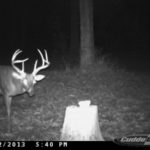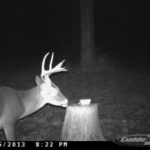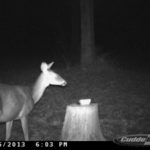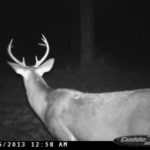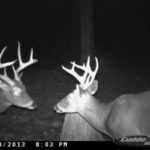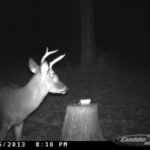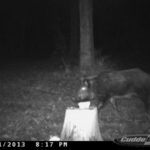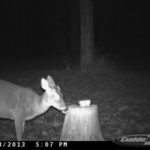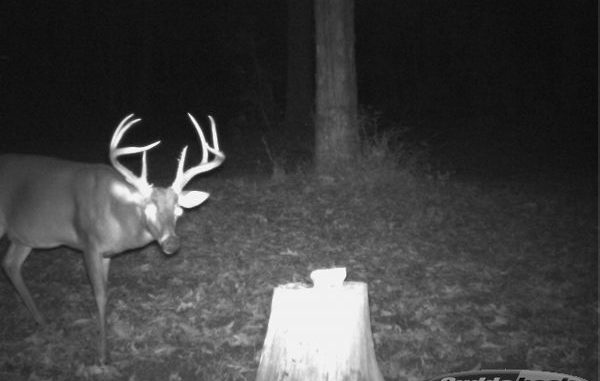
The first set of photos for you to consider shooting or passing over come from Area 4 — East Feliciana Parish.
This is dominant piney woods deer habitat, cattle pastures with no agriculture but with some food plots; keep in mind there were no acorns last year, so deer had to stuff themselves primarily with native browse.
Some of these deer were harvested, so we know their stats.
Because of the very cold winter last season, we do not expect too much from the deer this year with regard to growth and development.
So grab a pencil and paper, and jot down your response before reading my suggestion.
No. 1
This should be an easy decision for you.
Right off the bat, the photo shows a buck with an inside spread greater than the 15-inch ear width. The G-2s and G-3s of both beams are long, as are the brow tines (which are exceptional for this area, based on the data trends).
The buck has a pot belly, and the back is swayed. There is little distinction between the neck and chest.
Shoot this Feliciana buck!
It is probably 5 to 6 years old.
The buck was photographed many times before the season, but was never seen after hunting began. When bucks get old, they also get to be very smart and sharp, and might simply die of old age or natural mortality.
No. 2
The body and neck tells you this is an adult buck. The main beams are short based on our imaginary line from beam tip downward to the head.
The G-2s have good length but the overall antler mass is small, and this buck would not score 100 B&C.
Most hunters would probably pass on this buck and save the tag for a better one. However, since I am familiar with the growth trends of this deer herd, I would not be upset if you did say you would shoot it. It is at least 3 ½ years old.
Without an acorn crop last season to maintain the physical condition of this buck from the date of photo (Nov. 5) to the end of winter (February), it is going to have to work hard and eat whatever nutritional browse it can find just to maintain itself.
Come spring we might not see any significant increase in body and in its new set of antlers. This is low-quality habitat, and without a mast crop to help out, 2014 might be lacking in good bucks.
No. 3
A nice adult doe has come to the feeder. Note the large head, the small, slender neck and a big body (although data trends show it only weighs 110 or less).
The doe segment of the population has to be managed to keep the herd in balance with the habitat, so use an antlerless tag and put some meat in the freezer.
No. 4
The inside spread of this buck is much less than the width of the ears, so the inside spread is less than 15 inches. It has small brow points, and the G-2s and G-3s are also short; with a small inside spread, the main beams are going to be short also.
It is obvious that the antler mass is light and the circumferences will be less than 4 inches.
While it is an adult buck that might be 3 ½ years old, give it another year or two.
No. 5
You have two bucks to choose from, but the photo clearly shows that the 8-point on the left is the larger-racked buck. It has longer main beams and longer G-2s and G-3s.
This buck was harvested during the season and scored 123 inches B&C; it weighed 160 pounds and was 4 ½ years old.
It was definitely a quality buck for this habitat type and probably one that most hunters would consider to be a trophy buck.
Note that the G-2s of both bucks are about the same length and the antler mass is about the same. The buck on the right might very well be a 4-year-old also on this habitat.
No. 6
Most of you will look at this photo and would not even consider shooting it, But, this buck was 4 ½ years old, weighed 140 pounds and had five antlered points.
The visual appearance gives the hunter the impression that this is a young deer that might only be 1 ½ years old. But the data trends point to the fact that 1 ½-year-old bucks on this site weigh less than 110 pounds and are spikes with beams 6 inches or less in length.
It is obvious that this buck is heavier than 110 pounds, and the antlers are too large for the yearling age class. It was obvious to me when I pulled the trigger that it was a low-end adult buck showing very little promise.
I was surprised to see that it was older than 2 ½.
No. 7
Well, of course you shoot the hog — it is an outlaw quadruped that destroys habitat, spreads disease and creates problems for the deer.
However, look at the date and time of photo. It is illegal to take hogs at night from Sept. 1 to Feb. 28 (during the deer season). I guess LDWF is afraid that landowners will be shooting deer at night on their land instead of hogs. It is one of those laws designed to stop something that might happen from happening.
But the fact is landowners are not shooting their deer at night. This law does nothing to help resolve the feral hog problem.
The truth is the deer season is an excellent time to shoot hogs, especially at night. Hogs are eating acorns and coming to the feeders during the season, but most of that activity is at night because the hogs wise up once the hunting starts.
It is a bad law that needs to be changed. Landowners should be able to take hogs whenever they can on their property.
No. 8
Most hunters would not even think about shooting this young buck. It is so small it must be a 6-month-old that grew spikes.
Let it go and it will grow — except on this habitat it will not grow and become a quality buck.
Data trends show that this is really a 1 ½-year-old buck, and is lucky if it weighs 90 pounds, which it does not. If it did weigh 90 pounds, it might weigh 105 at age 2, 120 at age 3 and 135 at age 4.
It is a low-end yearling buck: Shoot it and get some very tender meat for the freezer.
